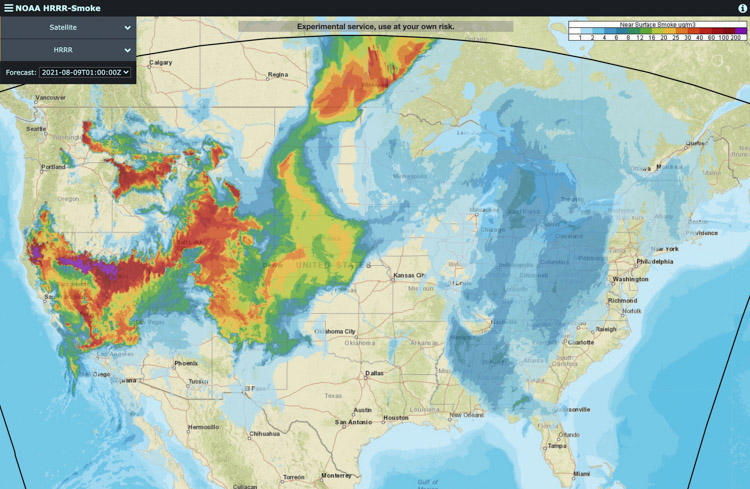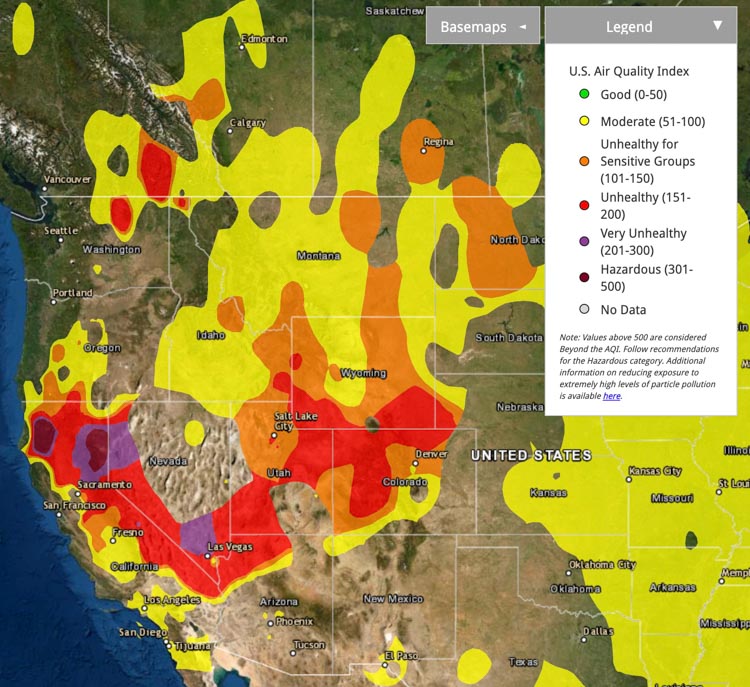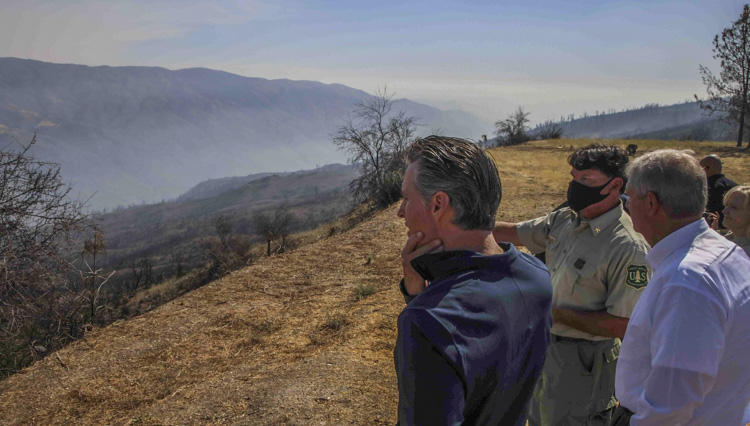
Wildfires in California, Oregon, Washington, Idaho, Montana, and Canada are creating smoke that is affecting air quality in most of the Western United States.

News and opinion about wildland fire
The Fly Fire merged with the Dixie Fire which also appears to have been started by the company’s equipment

12:58 p.m. PDT August 8, 2021
The Washington Post reported August 7 that a federal judge ordered PG&E to explain the utility company’s role in starting the Dixie and Fly Fires. The official causes of the fires are still under investigation, but U.S. District Judge William Alsup asked the company in an order issued late Friday to give details, by August 16, about the equipment and vegetation in the area where the fires started. Alsup oversees PG&E’s criminal probation for felony convictions stemming from the deadly 2010 San Bruno gas pipeline explosion.
On July 18 Pacific Gas and Electric (PG&E) told the California Public Utilities Commission (PUC) that on July 13 the company’s equipment may have ignited the Dixie Fire which at 453,000 acres has grown to become the second largest single fire in the recorded history of California.
To see all articles on Wildfire Today about the Dixie Fire, including the most recent, click HERE.
PG&E also said in another filing with the PUC on August 2 that its equipment may also be to blame for starting the Fly fire which eventually merged with the Dixie fire.
The Fly Fire was reported Thursday, July 22 near Keddie in Butterfly Valley about four miles north of Quincy. At first there was a question whether it was a spot fire from the Dixie Fire several miles away, or if it was unrelated. A fire behavior analysis determined the spot fire possibility was unlikely.
PG&E said that at about 5:01 p.m. on July 22 activity on SmartMeters, a line recloser, and alarms reported a problem, and the Gansner 1101 circuit was deenergized. Later PG&E assisted the U.S. Forest Service with moving and examining a tree that was resting on a conductor on the circuit.

Wildfires in Canada and the Western United States are having massive impacts on air quality in some locations, depending on the wind direction.
Above is the measured air quality at noon Pacific time.
Below are forecasts for wildland fire smoke, at 6 p.m. Saturday, and then Sunday.


“We have to have more boots on the ground”

On August 4 Governor Gavin Newsom, U.S. Agriculture Secretary Tom Vilsack, and new U.S. Forest Service Chief Randy Moore met at the burn scar of the 2020 August Complex of fires in Northern California to discuss state and federal collaboration on wildfire response and fuels management across the West.
During a press availability, Secretary Vilsack uttered words we don’t hear from Chiefs of the Forest Service, or certainly from Secretaries of Agriculture:
We are prepared to do a better job [of forest management] if we have the resources to be able to do this… Candidly, I think it’s fair to say over the generations and decades, we have tried to do this job on the cheap. We have tried to get by, a little here, a little there, with a little forest management here, a little fire suppression over here, but the reality is this has caught up to us.
We have to significantly beef up our capacity. We have to have more boots on the ground… And we have to make sure our firefighters are better compensated. Governor, that will happen.
We need to do a better job, and more, forest management to reduce the risk of catastrophic fire.
Governor Newsom said he has been exploring way to obtain more fire aviation resources, lamented that there are “only a few contracted DC-10s nationwide”, and said he was looking at how “to get the 747 back in our hands, and that’s been a challenge, that thing has been sold, so we’re still working to get some more aerial equipment.” (This statement is queued up in the video below.)
Secretary Vilsack said the Governor’s request for additional aviation resources, “… Came to my desk. One of the challenges we’re working on right now is making sure we get the Defense Department personnel necessary to fly the planes. So sometimes it’s not even the planes, it’s the pilots, the people who know how to fly these planes…I was given instructions to… make sure we have the people in the planes to fly them.”
The Secretary was most likely referring to the military Modular Airborne FireFighting Systems, MAFFS, which can be loaded into C-130 aircraft to temporarily serve as air tankers. They are the only military air tankers used on wildfires in the U.S. Each requires a seven-person crew, additional support personnel, and often a third conventional C-130 for every two MAFFS that are activated.
The Secretary’s comment could be the explanation for why only five of the eight MAFFS have been activated this year. On July 27, wondering if there was a specific reason why the remaining three were still parked, I asked US Forest Service spokesperson Stanton Florea if the three were available if needed. He replied on July 28, “There are 3 additional MAFFS-equipped C-130s that can be brought into service, if needed.”
As of today, August 6, there are still only five MAFFS working.


Most of the United States has some degree of smoke due to the fires in the western states and Canada, but the lighter concentrations may not be noticeable to most residents. If you have red sunrises and sunsets, it could be because of the smoke. Above is the near-surface smoke forecast for 4 a.m. MDT August 5, 2021.
Below are the Red Flag Warnings and Fire Weather Watches, issued August 4, 2021.

Temporary shift in policy due to extreme wildfire conditions in the West and competition for firefighting resources due in part to COVID-19 infections rising again
1:55 p.m. MDT August 3, 2021

In an August 2 letter to the field, new US Forest Service Chief Randy Moore said that because there is in a “national crisis”, they will not “manage fires for resource benefit”. In other words, instead of allowing fires to burn in order to replicate natural conditions and improve the ecosystem, they will put them out — at least to the best of their ability.
This year there are several factors that brought us to the crisis: competition for firefighting resources, a large number of incidents, firefighter numbers reduced by COVID-19 infections, and fire behavior enhanced by drought. It has all led to larger, longer-duration fires. Not mentioned by the Chief is the hundreds of vacant Forestry Technician positions. In early July there were 800 on National Forests in California alone.
During a virtual meeting July 27 with Western Governors to discuss wildfire preparedness, President Joe Biden was told that their states need more aviation resources, they need help with obtaining aviation fuel, they need more boots on the ground, and they encourage aggressive initial attack. The last item was referring to managing rather than suppressing fires. Governor Gavin Newsom referenced last month’s Tamarack Fire south of Lake Tahoe that was monitored but not suppressed. It stayed very small for 12 days until it grew rapidly, spreading east for 20 miles into Nevada, burning more than 68,000 acres and destroying 25 structures. On the August 3 National Situation Report it is still listed as a less than full suppression fire.
In declaring what is a temporary shift in policy until the Western fire season abates, Chief Moore cited numerous reasons for the change:
The 2021 fire year is different from any before. On July 14, 2021, the National Multi-Agency Coordination Group raised the national preparedness level (PL) to 5, the earliest point in a decade and the third earliest ever. There are currently over 70 large fires burning across the nation and 22,000 personnel responding, which are both nearly three times more than the 10-year average for the month of July. Severe drought is affecting over 70 percent of the West, and the potential for significant fire activity is predicted to be above normal into October. Our firefighters are fatigued, especially after more than a year of almost constant deployments, beginning with helping Australia in January 2020, and continuing through a difficult 2020 fire year and then supporting the vaccination effort in early 2021. In addition, COVID-19 infections are rising again. They are degrading our firefighting response capacity at an alarming rate, which will persist until more Americans are vaccinated.
In short, we are in a national crisis. At times like these, we must anchor to our core values, particularly safety. In PL 5, the reality is we are resource limited. The core tenet of the Forest Service’s fire response strategy is public and firefighter safety above all else. The current situation demands that we commit our fire resources only in instances where they have a high probability of success and they can operate safely and effectively. We will rely on the tested principles of risk management in determining our strategies and tactics.
Chief Moore said this was not a return to the “10 a.m. Policy” from 1935 which set as a goal stopping the spread of every fire by 10 a.m. the second day.
In addition, ignited prescribed fire operations will be considered only in geographic areas at or below Preparedness Level 2 and only with the approval of the Regional Forester after consulting with the Chief’s Office.
This directive only applies to the US Forest Service, and not to the four land management agencies in the Department of the Interior — National Park Service, Fish and Wildlife Service, Bureau of Indian Affairs, and Bureau of Land Management. Of those four DOI agencies, only the NPS is into “managed fire” in a big way. We asked a spokesperson for the NPS if they were making a similar temporary change in policy, but they were unable to meet our publication deadline, “given how busy it is and the need to work with the Washington Office of Communications”. [Update at 5:06 p.m. August 3. NPS Branch Chief for Communication and Education Tina Boehle got back to us with information which indicated the agency is not making any changes in their fire strategies — without actually stating it specifically.]
Currently there is a less than full suppression fire burning in North Cascades National Park in Washington which has blackened 150 acres, and another that has burned 470 acres in Yosemite NP in California. There are 18 listed on the Situation Report on National Forests, with most of them being in the Northern Rockies Geographic Area.
A video produced by the Northern Rockies Fire Science Network posted on YouTube last year was intended to spark discussion about managing fire for resource benefit on public lands. It featured interviews with 22 fire practitioners, including Dick Bahr, National Park Service Program Lead for Fire Science and Ecology, who said:
We have really good modeling now. … If you’re not comfortable with where it’s going to get or you’re concerned about what it’s going to burn up — do you take on the fire, or do you take on protection of what you’re going to do? And now the big shift is, we have now the opportunity, go put the money and the effort into protecting that point you’re worried about losing and let the fire do what it’s supposed to do…
You’re going to win a few, you’re going to lose a few. And it’s OK to lose, but you’ve got to learn from them.
Edited at 5:06 p.m. MDT August 3 to include late arriving information from the NPS which indicated that the agency is not making any changes in their fire strategies.